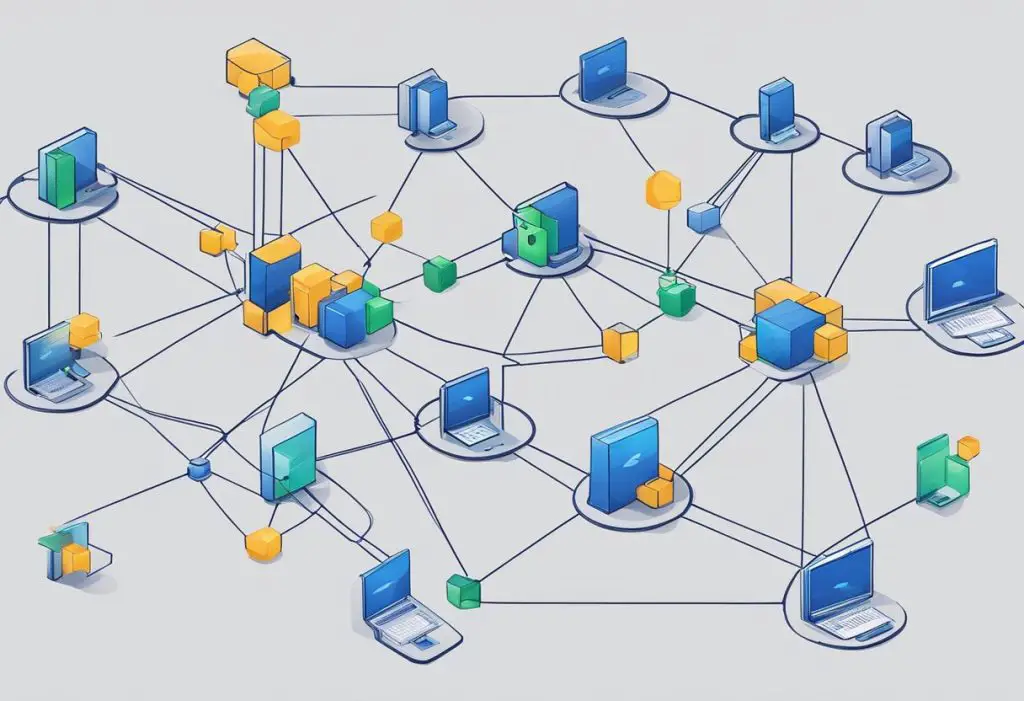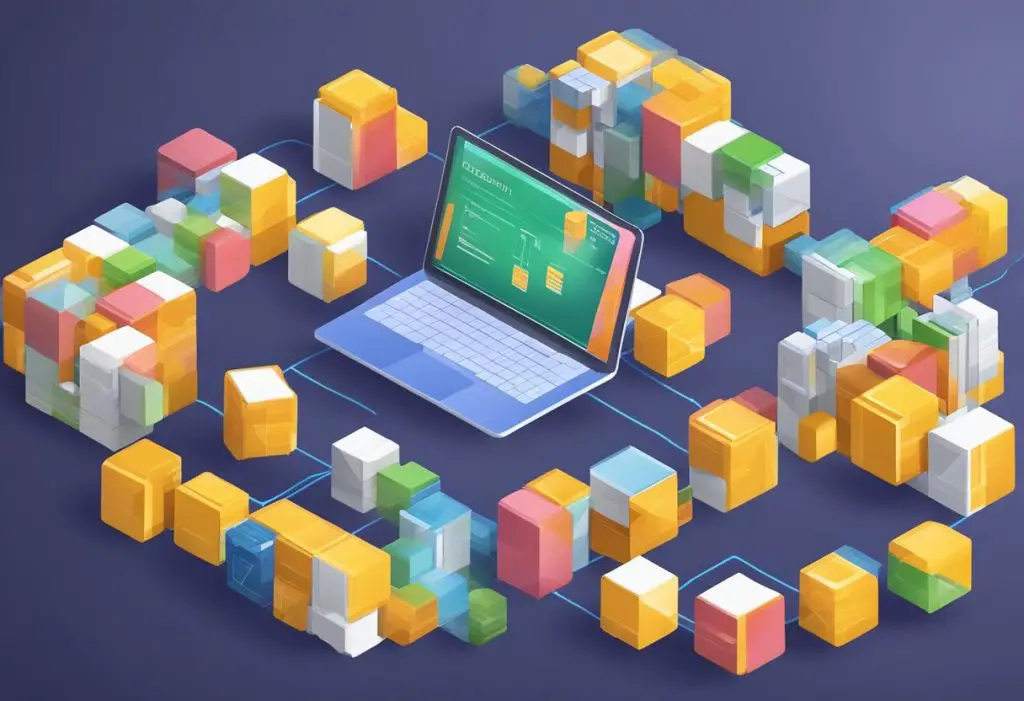Table of Contents
Introduction to Blockchain Transaction Process
Blockchain Transaction Process: Blockchain technology is a revolutionary innovation that has the potential to transform various industries, including finance, healthcare, and supply chain management. At its core, blockchain is a digital ledger that records transactions in a secure and transparent manner. The technology is decentralized, meaning that there is no central authority controlling the network. Instead, transactions are verified and added to the blockchain by a network of nodes that work together to maintain the integrity of the ledger.
Understanding the fundamentals of blockchain is essential to comprehending the blockchain transaction process. A blockchain transaction involves the transfer of digital assets, such as cryptocurrencies, from one user to another. When a transaction is initiated, it is broadcasted to the network of nodes, who then verify the transaction using complex algorithms. Once verified, the transaction is added to a block in the blockchain, which is then added to the existing chain of blocks. This process ensures that the transaction is secure, transparent, and immutable.
Key Takeaways Blockchain Transaction Process:
- Blockchain technology is a decentralized digital ledger that records transactions in a secure and transparent manner.
- A blockchain transaction involves the transfer of digital assets, such as cryptocurrencies, from one user to another.
- The blockchain transaction process involves the verification of transactions by a network of nodes, followed by the addition of the transaction to a block in the blockchain.
Understanding Blockchain Fundamentals

Blockchain Transaction Process Image 1
Defining Blockchain Technology
Blockchain is a distributed and decentralized technology that is used to create a public ledger of transactions. It is a digital ledger that records transactions in an immutable and secure way. The blockchain technology is based on a series of blocks that are linked together in a chain. Each block contains a set of transactions that are validated by a network of computers known as nodes. Once a block is added to the chain, it cannot be altered or deleted.
The Role of Cryptography
Cryptography plays a vital role in the blockchain technology. It is used to secure the transactions and ensure that they are legitimate. Cryptography is a technique that is used to convert plain text into a code that is unreadable without a key. In the blockchain technology, cryptography is used to create digital signatures that are used to verify the authenticity of transactions. These signatures are created using a private key that is known only to the owner of the transaction.
Types of Blockchains
There are two main types of blockchains: public and permissioned. Public blockchains are open to anyone, and anyone can participate in the network. These blockchains are decentralized, and no single entity controls them. Bitcoin is an example of a public blockchain. Permissioned blockchains, on the other hand, are controlled by a single entity or a group of entities. These blockchains are used in industries where privacy and security are of utmost importance. They are also known as private blockchains.
In conclusion, blockchain technology is a revolutionary technology that is transforming the way transactions are recorded and verified. It is a distributed and decentralized technology that is based on a series of blocks that are linked together in a chain. Cryptography plays a vital role in the blockchain technology, and it is used to secure the transactions and ensure that they are legitimate. There are two main types of blockchains: public and permissioned.
The Transaction Lifecycle

Blockchain Transaction Process Image 2
A transaction is the basic unit of data in a blockchain network. It is a record of the transfer of value from one participant to another. The transaction lifecycle in a blockchain network consists of three main stages: initiating a transaction, transaction verification process, and adding transactions to blocks.
Initiating a Transaction
To initiate a transaction, a user must have a private key, which is a secret code that allows them to access their funds. The user must also have the public key of the recipient, which is a unique identifier that is publicly available. The user then creates a transaction by specifying the amount of cryptocurrency they want to send, the recipient’s public key, and a transaction fee.
Transaction Verification Process
Once a transaction is initiated, it is broadcast to the network and added to the mempool, which is a pool of unconfirmed transactions. Miners, who are responsible for adding new blocks to the blockchain, then verify the transaction. They do this by checking that the transaction is valid, which means that the user has enough funds to cover the transaction and that the transaction fee is sufficient.
Adding Transactions to Blocks
Once a transaction is verified, it is added to a block. A block is a collection of transactions that is added to the blockchain. Before a block can be added to the blockchain, it must be verified by other nodes in the network. This is done through a consensus mechanism, which ensures that all nodes in the network agree on the state of the blockchain.
Each block has a maximum size, which is determined by the network’s protocol. Transactions that are too large to fit in a block are either rejected or split into smaller transactions. Transactions with a higher transaction fee are given priority and are added to the blockchain faster than transactions with a lower fee.
In summary, the transaction lifecycle in a blockchain network is a complex process that involves multiple entities and mechanisms. However, by understanding the basics of how transactions are initiated, verified, and added to the blockchain, users can participate in the network with confidence and security.
Consensus Mechanisms and Security

Blockchain Transaction Process Image 3
Blockchain technology is based on the concept of a decentralized network. In order for this network to function properly, there needs to be a mechanism in place that ensures agreement, trust, and security across the network. This mechanism is known as a consensus mechanism. Consensus mechanisms are critical to the security and integrity of blockchain networks.
Proof of Work vs. Proof of Stake
There are different types of consensus mechanisms used by blockchain networks. The most well-known ones are Proof of Work (PoW) and Proof of Stake (PoS). PoW is the mechanism used by the Bitcoin network, while PoS is used by networks such as Ethereum.
PoW works by having miners compete to solve complex mathematical problems in order to validate transactions and add new blocks to the blockchain. The first miner to solve the problem is rewarded with new coins. This process is known as mining.
PoS, on the other hand, works by having validators stake their own coins as collateral to validate transactions. Validators are chosen based on the amount of coins they have staked. The more coins they stake, the higher the chances of being selected to validate transactions.
Dealing with Security Threats
One of the biggest threats to the security of blockchain networks is the 51% attack. This is when an attacker gains control of 51% or more of the network’s computing power. With this much power, the attacker can rewrite the blockchain and reverse transactions.
To prevent this from happening, blockchain networks have measures in place to ensure immutability. Immutability refers to the fact that once a transaction has been added to the blockchain, it cannot be altered or deleted. This is achieved through the use of cryptographic hashes, which make it virtually impossible to alter the contents of a block without being detected.
In conclusion, consensus mechanisms are crucial to the security and integrity of blockchain networks. PoW and PoS are two of the most well-known mechanisms, but there are others as well. To ensure immutability and prevent attacks such as the 51% attack, blockchain networks have measures in place such as cryptographic hashes.
Blockchain Applications and the Future

Blockchain Transaction Process Image 4
Smart Contracts and DApps
One of the most significant applications of blockchain technology is the use of smart contracts. Smart contracts are self-executing contracts with the terms of the agreement between buyer and seller being directly written into lines of code. Smart contracts are tamper-proof and can be programmed to automatically execute when certain conditions are met, making them ideal for a wide range of applications.
Decentralized applications (DApps) are another area where blockchain technology is being used. DApps are applications that run on a decentralized network of computers, rather than a single server. Ethereum is one of the most popular blockchain platforms for building decentralized applications.
Blockchain in Various Industries
Blockchain technology is being used in various industries, including finance, healthcare, and logistics. One of the most significant benefits of blockchain technology is its ability to create a tamper-proof and transparent ledger of transactions.
Non-fungible tokens (NFTs) are a type of digital asset that is becoming increasingly popular. NFTs are unique digital assets that can represent anything from artwork to music. The use of blockchain technology ensures that NFTs are tamper-proof and cannot be duplicated.
Intellectual property is another area where blockchain technology is being used. Blockchain technology can be used to create a tamper-proof ledger of intellectual property rights, ensuring that they are protected and cannot be duplicated.
In the music industry, blockchain technology is being used to create a transparent and fair distribution system for royalties. This ensures that artists are paid fairly for their work and that royalties are distributed in a transparent and efficient manner.
Overall, the future of blockchain technology looks bright. As more industries adopt blockchain technology, we can expect to see more innovative applications and use cases emerge.
Frequently Asked Questions

Blockchain Transaction Process Image 5
What are the key stages involved in processing a transaction on a blockchain?
A blockchain transaction involves several key stages, including validation, propagation, and confirmation. During the validation stage, the transaction is verified by the nodes on the blockchain network and added to a block. Once the block is complete, it is propagated to other nodes on the network. Finally, the block is confirmed when it is added to the blockchain and becomes a permanent part of the ledger.
Can you provide an example of a blockchain transaction?
A typical blockchain transaction involves a sender, a recipient, and a transfer of digital assets, such as cryptocurrency. For example, if Alice wants to send Bob 1 Bitcoin, she would create a transaction on the Bitcoin blockchain network, specifying Bob’s public key as the recipient and the amount of Bitcoin she wants to send. Once the transaction is validated and confirmed, the Bitcoin is transferred from Alice’s wallet to Bob’s wallet.
How does blockchain technology function in layman’s terms?
Blockchain technology is a decentralized, distributed ledger that records transactions in a secure, transparent, and immutable manner. Each block in the blockchain contains a cryptographic hash of the previous block, creating a chain of blocks that cannot be altered without invalidating the entire chain. This makes it virtually impossible to tamper with the data stored on the blockchain, ensuring the integrity and authenticity of the transactions.
What are the different types of blockchains and their distinct features?
There are several types of blockchains, including public, private, and consortium blockchains. Public blockchains, such as Bitcoin and Ethereum, are open to anyone and allow for anonymous transactions. Private blockchains, on the other hand, are permissioned and require authorization to access. Consortium blockchains are a hybrid of public and private blockchains, where a group of organizations come together to operate the network.
What is the role of blockchain in cryptocurrency transactions?
Blockchain technology is the backbone of cryptocurrency transactions, providing a secure and transparent way to transfer digital assets without the need for intermediaries, such as banks or financial institutions. By using a decentralized network of nodes to validate and confirm transactions, blockchain technology eliminates the need for trust between parties, making it a revolutionary technology for the financial industry.
What occurs during the lifecycle of a blockchain transaction?
During the lifecycle of a blockchain transaction, several key events take place, including validation, propagation, confirmation, and settlement. Once a transaction is validated and propagated to other nodes on the network, it is confirmed when it is added to the blockchain and becomes a permanent part of the ledger. Finally, the settlement occurs when the digital assets are transferred from the sender’s wallet to the recipient’s wallet.

